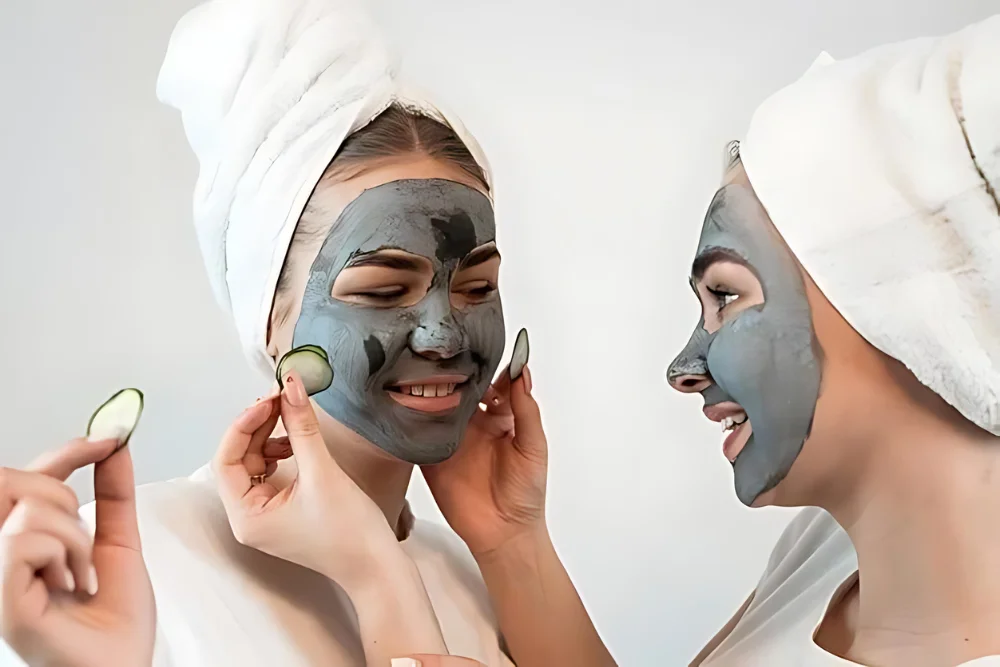Clay masks have been used for centuries and are loved for their ability to make skin healthier. They’ve been part of beauty routines for a long time – from ancient times to now. People still use them because they can help with many different skin issues. This guide will tell you all about the different types of clay masks, why they’re good for your skin, and how to use them to get the best results.
Types of Clay Masks and Their Unique Benefits
Understanding the different types of clay masks is essential for choosing the right one for your needs. Each type of clay has unique properties that cater to specific skin concerns.
-
Bentonite Clay
Origin & Composition: Bentonite clay is derived from volcanic ash and is renowned for its exceptional absorbent properties. This clay forms when volcanic ash breaks down into tiny glass particles.
Benefits:
- Absorbs Excess Oil and Toxins: Bentonite clay is highly effective at drawing out excess oil and toxins from the skin, making it ideal for managing oily skin.
- Helps Manage Acne: By absorbing oil and impurities, it helps to reduce acne and manage breakouts.
- Improves Symptoms of Dermatitis and Diaper Rash: Studies have shown that bentonite clay can improve skin conditions such as dermatitis and diaper rash.
Usage: Best suited for oily skin types. Caution is advised for dry skin, as its strong absorbency can lead to excessive dryness.
-
Kaolin Clay
Origin & Composition: Kaolin clay, also known as China clay, is a soft white clay known for its gentle nature. It is used in various products, including porcelain and paper.
Benefits:
- Controls Oil Without Excessive Drying: Kaolin clay helps to balance oil production while preventing over-drying.
- Soothes Skin and Reduces Blemishes: It has soothing properties that can reduce redness and blemishes.
- Suitable for Sensitive Skin Types: Its gentle nature makes it appropriate for those with sensitive skin.
Variations: Kaolin clay comes in several forms, including pink, white, and Australian pink clay, each catering to different skin needs.
-
French Green Clay
Origin & Composition: Sourced from France, this mineral-rich clay gets its green color from decomposed plant matter.
Benefits:
- Detoxifies and Clears Pores: French green clay is excellent for drawing out impurities from the skin and cleansing pores.
- Promotes Circulation and May Reduce Bacterial Growth: It may help improve blood circulation and has potential antibacterial properties.
Special Uses: While promising, more research is needed to fully understand its benefits for certain skin conditions.
-
Rhassoul Clay
Origin & Composition: Rhassoul clay, also known as Ghassoul clay, hails from Morocco and is renowned for its skin-rejuvenating properties.
Benefits:
- Enhances Skin Elasticity and Texture: It is known to improve skin texture and elasticity.
- Suitable for Sensitive and Mature Skin: Its gentle nature makes it a good option for those with sensitive or mature skin.
Traditional Uses: Historically used for both skin and hair care.
Also Read- Achieving Youthful Skin: Anti-Aging Skincare Tips and Lifestyle Advice
Applications and Benefits for Skin

Clay masks offer a range of benefits depending on your skin type and concerns.
Acne Treatment
- How It Works: Clay masks, particularly those containing bentonite, help absorb excess oil and manage mild acne. Mixing clay powder with warm water enhances the mask’s effectiveness by increasing perspiration and oil release.
- Best Practices: Use a clay mask once or twice a week. For severe acne, consult a healthcare professional for appropriate treatment options.
Oily Skin Management
- How It Works: Clay masks draw out excess oil and reduce shine, making them ideal for those with oily skin.
- Best Practices: Apply the mask once or twice a week to manage oil buildup and maintain a balanced complexion.
Dry Skin Treatment
- How It Works: Red clay can create a moisture-retaining film on the skin, which may be beneficial for dry skin.
- Best Practices: Limit use to prevent excessive dryness. Follow up with a hydrating moisturizer to maintain skin moisture levels.
Toxin Removal
- How It Works: The negative electrical charge of clay can bind to and remove toxins and heavy metals from the skin.
- Best Practices: Regular use of clay masks may aid in detoxification, contributing to overall skin health.
Special Conditions
- Conditions Treated: While research is limited, some people find clay masks beneficial for conditions like dermatitis, eczema, and psoriasis.
- Current Research: Although anecdotal evidence supports these uses, more research is needed to confirm their effectiveness.
Applications and Benefits for Hair
Clay masks are not only beneficial for the skin but can also improve hair health.
Scalp Health
- Benefits: Clay masks may help with issues like dandruff, dryness, and frizziness. They can cleanse the scalp and remove buildup.
- Claims vs. Reality: There is no conclusive evidence that clay masks increase hair growth in humans, despite historical studies suggesting benefits in animals.
How to Use a Clay Mask
Proper application and use are key to maximizing the benefits of clay masks.
-
Preparation
Cleanse Face: Start with a clean face to ensure the mask can penetrate effectively.
-
Application
Tips: Apply an even layer of the mask, typically 10-15 minutes, avoiding sensitive areas like the eyes. Use a clean applicator or your fingers for application.
-
Removal
Methods: Rinse off the mask with lukewarm water or a damp cloth to avoid irritation. Follow with a gentle patting to dry your face.
-
Post-Application Care
Moisturize: After removing the mask, apply a moisturizer suited to your skin type to maintain hydration.
Also Read- Top 5 Soaps for Tan Removal in India: Expert Reviews & Buyer’s Guide
Safety Considerations and Side Effects
While clay masks are generally safe, it’s important to be aware of potential side effects and precautions.
Common Issues
- Dryness, Itchiness, Redness: These can occur if the mask is used too frequently or left on too long.
- Patch Testing: Always test a new mask on a small area of skin before full application to avoid adverse reactions.
Precautions
- Avoid Harsh Additives: Check ingredient lists to avoid potential irritants.
- Monitoring Reactions: Pay attention to how your skin responds and adjust use accordingly.
Choosing the Right Clay Mask
- Selecting the right clay mask is crucial for achieving the desired results.
Identifying Your Skin Type
- Categories: Determine if your skin is dry, oily, combination, normal, or sensitive.
Matching Masks to Concerns
- Considerations: Choose masks based on specific needs such as acne, oil control, or hydration.
Brand and Product Selection
- Research: Opt for reputable brands and consult professionals for recommendations tailored to your skin type and concerns.
Conclusion
Clay masks have a rich history and remain a popular choice for enhancing skin health. They offer a range of benefits, from oil absorption and acne management to toxin removal and scalp health. By understanding the different types of clay masks and their specific benefits, you can make an informed choice that suits your needs. Remember to use masks responsibly to avoid potential side effects and consult with skincare experts for personalized advice.
Final Tip: Incorporate clay masks into your routine wisely, and enjoy the rejuvenating effects they offer for both your skin and hair.








